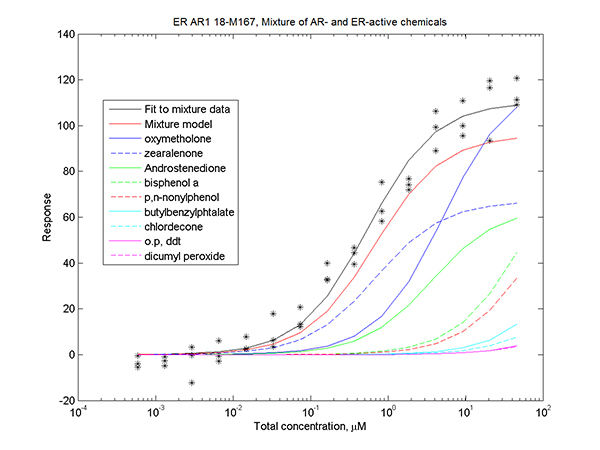Much of the work carried out by DTT is in support of the National Toxicology Program (NTP), an interagency partnership of the Food and Drug Administration, National Institute for Occupational Safety and Health, and NIEHS.
Toxicoinformatics Group

Mathematical Statistician
Fred Parham, Ph.D., is a mathematical statistician in the Toxicoinformatics Group within the Predictive Toxicology Branch of the Division of Translational Toxicology. He came to the Branch in the summer of 2010 after spending several years working in the Environmental Systems Biology group of the NIEHS Division of Intramural Research. He is currently working on various projects involving the analysis and interpretation of high throughput screening data. He received his B. S. in mathematics from Duke University in 1984 and his Ph. D. from Princeton University in 1989.

ER AR1 18-M167, Mixture of AR- and ER-active chemicals
Recent Publications
-
Pelch K, Wignall J, Goldstone A, Ross P, Blain R, Shapiro A, Holmgren S, Hsieh J, Svoboda D, Auerbach S, Parham F, Masten S, Walker V, Rooney A, Thayer K. A scoping review of the health and toxicological activity of bisphenol A (BPA) structural analogues and functional alternatives.
Toxicology.
2019 Aug 01;424:152235.
[
AbstractPelch K, Wignall J, Goldstone A, Ross P, Blain R, Shapiro A, Holmgren S, Hsieh J, Svoboda D, Auerbach S, Parham F, Masten S, Walker V, Rooney A, Thayer K. A scoping review of the health and toxicological activity of bisphenol A (BPA) structural analogues and functional alternatives. Toxicology. 2019 Aug 01
]
-
Pelch K, Wignall J, Goldstone A, Ross P, Blain R, Shapiro A, Holmgren S, Hsieh J, Svoboda D, Auerbach S, Parham F, Masten S, Thayer K. NTP Research Report on Biological Activity of Bisphenol A (BPA) Structural Analogues and Functional Alternatives: Research Report 4
NTP Research Reports.
2017 Oct [Epub ahead of print].
[
AbstractPelch K, Wignall J, Goldstone A, Ross P, Blain R, Shapiro A, Holmgren S, Hsieh J, Svoboda D, Auerbach S, Parham F, Masten S, Thayer K. NTP Research Report on Biological Activity of Bisphenol A (BPA) Structural Analogues and Functional Alternatives: Research Report 4 NTP Research Reports. 2017 Oct
]
-
Thomas R, Gohlke J, Stopper G, Parham F, Portier C. Choosing the right path: enhancement of biologically relevant sets of genes or proteins using pathway structure.
Genome biology.
2009;10(4):R44.
[
AbstractThomas R, Gohlke J, Stopper G, Parham F, Portier C. Choosing the right path: enhancement of biologically relevant sets of genes or proteins using pathway structure. Genome biology. 2009
]
-
Gohlke J, Armant O, Parham F, Smith M, Zimmer C, Castro D, Nguyen L, Parker J, Gradwohl G, Portier C, Guillemot F. Characterization of the proneural gene regulatory network during mouse telencephalon development.
BMC biology.
2008 Mar 31;6:15.
[
AbstractGohlke J, Armant O, Parham F, Smith M, Zimmer C, Castro D, Nguyen L, Parker J, Gradwohl G, Portier C, Guillemot F. Characterization of the proneural gene regulatory network during mouse telencephalon development. BMC biology. 2008 Mar 31
]
-
Toyoshiba H, Sone H, Yamanaka T, Parham F, Irwin R, Boorman G, Portier C. Gene interaction network analysis suggests differences between high and low doses of acetaminophen.
Toxicology and applied pharmacology.
2006 Sep 15;215(3):306-16.
[
AbstractToyoshiba H, Sone H, Yamanaka T, Parham F, Irwin R, Boorman G, Portier C. Gene interaction network analysis suggests differences between high and low doses of acetaminophen. Toxicology and applied pharmacology. 2006 Sep 15
]
NTP Reports





